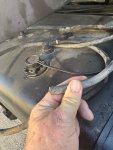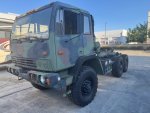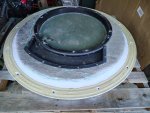Small progress today. One of the air fittings hasn't arrived, so I worked on removing the AOH pump and the spare tire lift. One bolt removed from the spare tire lift, 4 bolts removed holding the AOH pump. All 5 bolts very annoying to remove, difficult to get the wrench on the nuts. But a little progress.
I may need to back the truck out of the garage to get at the remaining bolts on the spare tire lift, I think at least one of them will require tilting the cab up and I can't do that in the garage. That's for another day.
Now I'm starting to think about the hatch on the cab. Most of the bolts are halfway in . . . so removing them will be easier . . . Then, I believe I'll clean the surfaces, thread the bolts barely in and have a 3 props, small wooden props, maybe pieces of 1x2 or a couple of paint sticks, holding the hatch off the roof while I apply Sikaflex 252. Then one at a time, remove the props and fill in 252. Then turn in the bolts tightly and clean up with Sika remover 208.
That should be waterproof, but after it cures, I'll do another bead of caulking.
Sound OK? Better suggestions?





